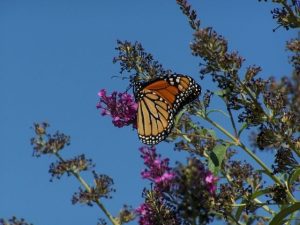Hundreds of millions of travelers migrate annually from Canada and the Northern US to warmer over winter sites in Mexico and Southern California. They arrive by fall, covering buildings and trees like a beautiful orange, black, and white cloud.
The Monarch Butterfly travels by instincts finding their way to sanctuaries in the high mountains of Mexico, waiting for the winter to close and spring to warm the path to the north. The Monarch trail north becomes a search for the tender shoots of the milkweed plant, the only plant where they lay their eggs and feed their young. Millions of butterflies head up the flyways of California searching for food, water, and resting sites.
Monarch butterflies are under strain with the march each direction. As they head north it may take up to four generations to reach the Canadian border. Each generation lives two to six weeks as adults. The fourth generation becomes the generation that returns to Mexico and reproduces there to start the process over the following spring. As for many living beings, the butterfly habitat is waning. Their main food source, milkweed and nectar, are in short supply for many reasons. Drought, development, roadside management, and herbicides have reduced the feeding grounds significantly. With a cry for help from many organizations, Monarch Waystations have been developed to help the Monarchs on their journey.
A local great example of a Monarch Waystation is in Jamestown at Sierra Waldorf School. One instructor and her fledging K-6th grade students have a working garden with chickens, goats, large beds of vegetables, flowers, and a Monarch Waystation. The first thing you notice in their garden is the multitude of flowers, all providing nectar for hungry travelers. Milkweed is also available for the hungry hatchlings. Sierra Waldorf School is growing vegetables, a new generation of butterflies, and a new generation of gardeners.
Monarch Waystations are a small way that everyone could help the continuing existence of this species. All you need is a sunny spot, the right plants, a water supply, and protection from the elements. Pick a spot that receives at least six hours a day of sun. Choose your host plants. If you would like to be a certified waystation like Sierra Waldorf School, you will need at least ten milkweed plants. Probably many of the plants that provide nectar already exist in your garden. Perennials like lavender, sedum, salvia, butterfly bush, Shasta daisy, and coneflowers. Add annuals like zinnias, cosmos, and sweet William and you are heading for a five star rating for your monarch motel. One important note, monarch caterpillars are like teenagers, they will eat twenty milkweed leaves a day. Without enough milkweed they will starve.
Water is very important for all butterflies. With short little legs, their waterholes are more like a puddle. Actually puddles are a favorite; they absorb salt and minerals that way. Another source is to use large pot saucers filled with sand, gravel, and water, just very shallow. Also shade and a windbreak make for butterfly perfection. Plantings that are tight give the butterflies protection from predators.
It is not every day that we can help a species on its 3000 mile travels. Most gardens probably have several of the needed elements to build your own waystation. The most difficult element might be the milkweed seeds. An internet search for Monarch Waystation will lead you to a program that sells seeds for a nominal fee, specific to gardens west of the Rockies.
After your waystation is up and growing, there is only one more thing you will need – a chair to sit in while you watch your travelers as they stop to visit your butterfly hotel.
Julie Silva is a University of California Cooperative Extension Master Gardener of Tuolumne County.


